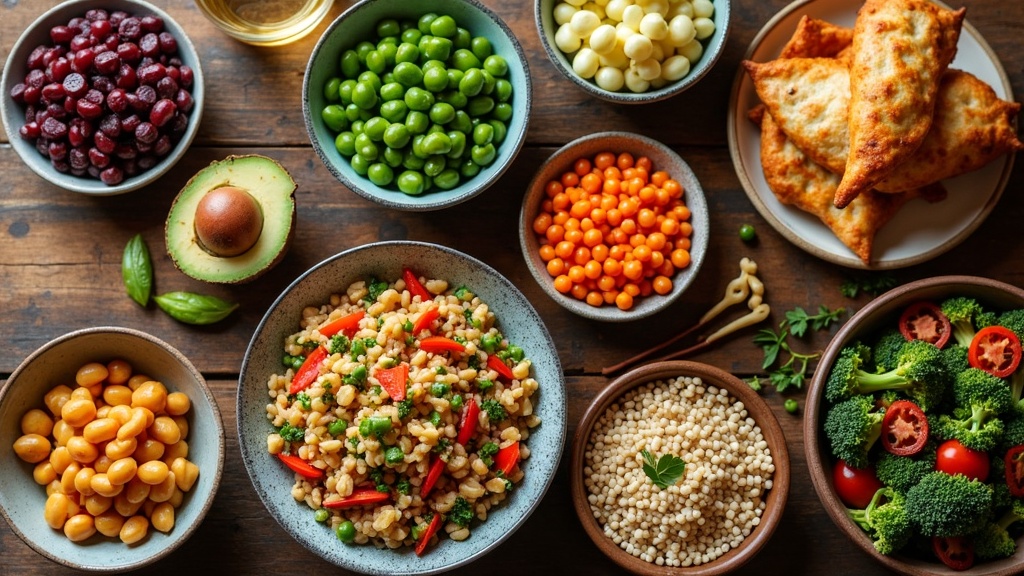Maintaining a healthy plantbased diet on a budget can sound like a serious challenge, but it’s actually pretty doable with some planning and a few practical tricks.
If you’re trying to eat more greens, beans, and grains without watching your grocery bill skyrocket, you’re definitely not alone.
Over the past decade, plantbased eating has become more popular, thanks in part to its health perks and its positive impact on the environment.
With demand growing, the world of plantbased meals has opened up way beyond just salads and stir fries.

Why More People Are Choosing PlantBased Diets, and Why Budget Matters
Plantbased eating has roots in cultures around the world, but lately, it’s hit mainstream status.
Whether it’s for health reasons, lowering your carbon footprint, or just wanting to try new foods, lots of people are jumping on board.
Research even backs up the benefits.
Studies from organizations like the Academy of Nutrition and Dietetics have linked plantbased diets with lower risks of heart disease, diabetes, and certain types of cancer.
But if you’ve browsed the “vegan” section at the grocery store recently, you’ve probably noticed how pricey those mock meats, snacks, and nondairy cheeses can get.
Sticking with whole, simple foods and a little knowhow can keep your grocery trips much more affordable.
It’s about smart shopping, basic cooking skills, and knowing which foods give you the best nutrition for your dollar.
And with a little planning, you can enjoy nutritious, filling meals all week long without breaking the bank.
Breaking Down the Basics: What Makes a Balanced PlantBased Diet?
The key to feeling great and staying full on a budgetfriendly plantbased diet is getting enough variety. Here’s a quick rundown of foods I always go for to cover the nutrition bases:
- Protein sources: Beans, lentils, chickpeas, tofu, tempeh, and unsalted peanuts. These are all super filling and easy to bulk buy.
- Whole grains: Rice, oats, barley, whole wheat pasta, and quinoa go a long way and pack in fiber and minerals.
- Vegetables: Fresh, frozen, and even canned (just rinse to reduce sodium) can all work. Root veggies like carrots and potatoes tend to be cheap and filling.
- Fruit: Bananas, apples, and frozen berries cover snacks and breakfasts. Buying in season makes a difference in price.
- Healthy fats: Think avocado (when affordable), sunflower seeds, flaxseeds, and olive or canola oil in moderation.
Each meal should get some mix of these.
I keep it loose, but making sure every plate has a little protein, veg, and whole grain really keeps energy up and cravings down.
If you’re worried about getting bored, just try different combinations and spice blends to make each meal feel new.
5 Steps to Create BudgetFriendly PlantBased Meals
- Plan your meals: I always map out 3-5 dinner ideas for the week, then build lunches and breakfasts around what’s left.
- Shop with a list: Writing it down helps stop impulse buys, especially in the snack aisle.
- Buy in bulk when you can: Dry beans, lentils, oats, and rice cost less per serving this way.
- Prep in advance: Cooking a big batch of beans or grains on Sunday means quick meals the rest of the week.
- Use leftovers wisely: I turn extra veggies or grains into soups, salads, or veggie burgers.
I find that creating a weekly routine, but leaving space to swap in ingredients if something goes on sale, keeps meals interesting while sticking to the plan.
Flexibility lets you take advantage of specials or seasonal deals at the store.
Also, by batchcooking things like chili or lentil stew, I always have something to fall back on.
If you’ve never tried slowcooking beans, now’s the time. It’s simple, cheap, and fills your kitchen with great smells.
Common Budget Challenges with PlantBased Eating (And How to Outsmart Them)
While a plantbased diet can absolutely be affordable, there are a few hurdles that pop up, especially if you’re new to it.
Here are some typical challenges and ways I work around them:
- Processed plantbased foods are expensive: Instead of leaning on frozen veggie burgers or dairyfree cheese, I use lentils for taco filling or oats and bananas for pancakes.
- Lack of time for meal prep: Chopping a bunch of veggies at once and batchcooking grains or beans means I can just grab and go.
- Getting enough protein: Beans, lentils, tofu, and peanut butter all come in at a much lower price than faux meats but hit protein needs just fine.
- Fresh produce goes bad: I pick a few sturdy veggies (like carrots or cabbage), and always keep frozen options on hand for backup.
Smart Swaps: Saving Money without Missing Out
Sometimes, I get tempted by those fancy vegan cheeses or cashew based yogurts, but swapping these for homemade or simpler options saves a lot.
For creamy sauces, I blend soaked sunflower seeds or silken tofu.
Instead of storebought veggie burgers, homemade black bean patties freeze well and use super cheap ingredients.
These swaps keep my budget in check and often taste even better.
Don’t Forget Nutrition: Key Nutrients Worth Watching
- Vitamin B12: This one doesn’t come from plants naturally, so I use a daily supplement or buy fortified soy or oat milk.
- Iron: Beans and lentils are great. Adding a squeeze of lemon juice helps your body absorb it better.
- Omega-3s: Flaxseed or chia seeds stirred into oatmeal cover this without fish oil.
- Calcium: Fortified nondairy milk, tofu set with calcium, and leafy greens work well.
Spending a few bucks on B12 is pretty important, but most other nutrients can be found for cheap with just a little planning.
It’s all about building your meals around nutrientrich basics and using supplements only where you really need them.
How to Shop for PlantBased Groceries on a Budget
Grocery shopping is where I feel the budget hits the hardest if I’m not careful. My main tips are:
- Stick to the outer aisles: Most whole plant foods—produce, grains, beans—are found on the edges of the store and are usually less expensive than the processed foods in the middle aisles.
- Embrace store brands: Storebrand beans, lentils, and frozen veg taste just as good as name brands for a lot less money.
- Keep it seasonal: I check what fruits and veggies are in season locally and use those as the base for my meals, since prices drop when supply is higher.
- Try international stores: Asian, Middle Eastern, or Latin grocery shops often have different varieties of beans, spices, and grains for cheaper than chain supermarkets.
One more tip: freeze excess produce or cooked meals so nothing goes to waste when you find a great deal.
Quick Tips for Cooking BudgetFriendly PlantBased Meals
- Soup is your friend: I toss leftover veggies, beans, and a grain into a pot with broth and spices. Super filling and barely costs anything per bowl.
- Stirfry magic: Using a combo of frozen and fresh veggies with tofu over rice is my goto for easy lunches.
- Bake big batches: I often roast trays of potatoes and carrots, then use them throughout the week to toss into salads or wraps.
- Freezer meals: Doubling recipes means extra portions for busy days. Chili, curries, and beanbased burgers freeze great.
Keeping meals simple (and repeating favorites) is sometimes the best way to cut down costs and time in the kitchen.
If you experiment with spices, even a basic lentil soup becomes something new every week.
Frequently Asked Questions
Here are a few of the questions I hear all the time about eating plantbased on the cheap:
Question: How do I get enough protein?
Answer:
Beans, lentils, tofu, tempeh, whole grains, and nuts all provide protein.
Mixing and matching these through the week easily covers your needs.
There’s no need for pricey meat alternatives.
Question: Is buying organic necessary?
Answer:
Not always. If you’re on a tight budget, focus on more affordable produce (even if it isn’t organic).
Frozen and canned veggies are also really good options and usually less expensive.
Question: How can I avoid food waste?
Answer:
Plan meals for the week, store leftovers in clear containers so you see (and use) them, and keep a running list of what’s in your freezer and pantry.
I also use up wilting veggies in soups or smoothies. This saves money and cuts down on trips to the store.
Making PlantBased Eating BudgetFriendly LongTerm
Staying plantbased and within your budget is all about building good habits.
I set a grocery budget for the month and keep track, so I can tell if I’m starting to go overboard on special items.
With time, the pantry fills up with basics and you don’t have to buy everything at once.
The biggest wins usually come from skipping costly processed foods, planning meals ahead, and sticking with my regular favorites.
Cooking at home is almost always cheaper than eating out, even when I splurge on a few special items.
Over time, little savings add up.
Money saved at the store can go toward days out, fun hobbies, or whatever else makes life more enjoyable.
Eating a nutritious, balanced, plantbased diet on a budget isn’t about missing out at all.
It’s about using what you’ve got in smart ways and finding flavors you love without spending big.
The variety and tastes you can stumble upon—while keeping your wallet happy—are pretty awesome once you get into the swing of it.
Stick with it, and you’ll see just how doable (and tasty) plantbased eating can be, no matter your budget.
